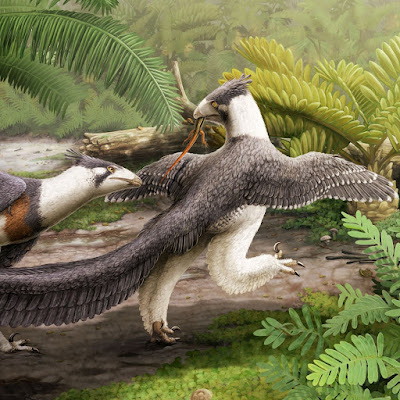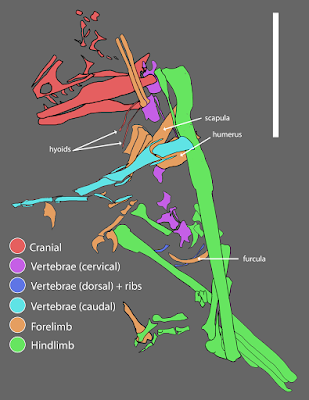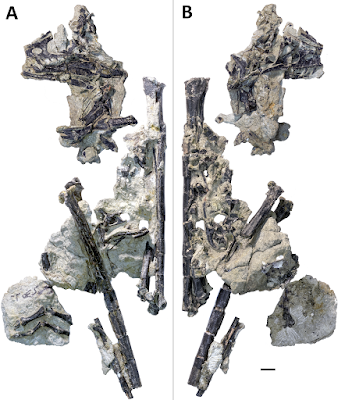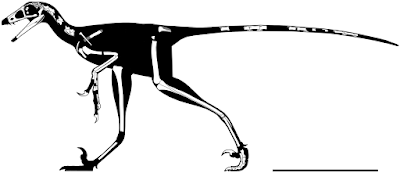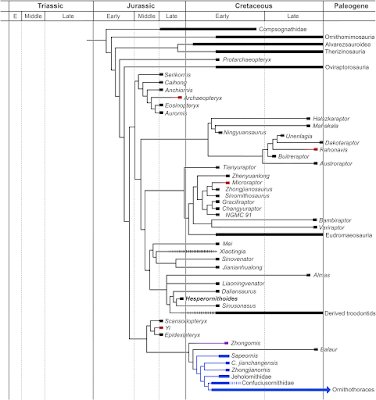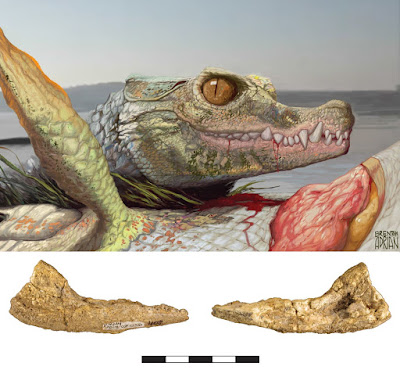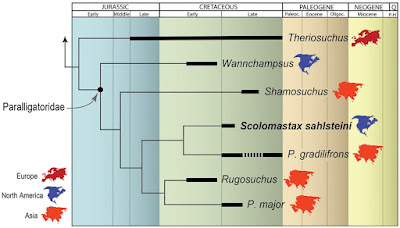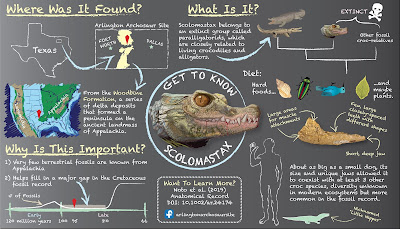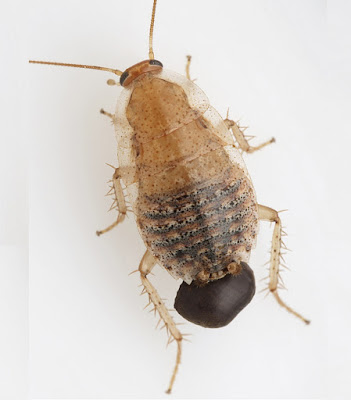[Most Recent Entries] [Calendar View]
Thursday, July 11th, 2019
| Time | Event | ||||||||
| 2:39a | [Paleontology • 2019] Hesperornithoides miessleri • A New Paravian Dinosaur from the Late Jurassic of North America supports A Late Acquisition of Avian Flight
Abstract The last two decades have seen a remarkable increase in the known diversity of basal avialans and their paravian relatives. The lack of resolution in the relationships of these groups combined with attributing the behavior of specialized taxa to the base of Paraves has clouded interpretations of the origin of avialan flight. Here, we describe Hesperornithoides miessleri gen. et sp. nov., a new paravian theropod from the Morrison Formation (Late Jurassic) of Wyoming, USA, represented by a single adult or subadult specimen comprising a partial, well-preserved skull and postcranial skeleton. Limb proportions firmly establish Hesperornithoides as occupying a terrestrial, non-volant lifestyle. Our phylogenetic analysis emphasizes extensive taxonomic sampling and robust character construction, recovering the new taxon most parsimoniously as a troodontid close to Daliansaurus, Xixiasaurus, and Sinusonasus. Multiple alternative paravian topologies have similar degrees of support, but proposals of basal paravian archaeopterygids, avialan microraptorians, and Rahonavis being closer to Pygostylia than archaeopterygids or unenlagiines are strongly rejected. All parsimonious results support the hypothesis that each early paravian clade was plesiomorphically flightless, raising the possibility that avian flight originated as late as the Late Jurassic or Early Cretaceous.
Systematic Palaeontology Theropoda Marsh, 1881 Maniraptora Gauthier, 1986 Paraves Sereno, 1997 Deinonychosauria Colbert & Russell, 1969 Troodontidae Gilmore, 1924 Hesperornithoides miessleri gen. et sp. nov. Holotype: WYDICE-DML-001 (Wyoming Dinosaur Center, Thermopolis), a single, partially articulated skeleton consisting of most of an articulated skull and mandibles missing the anteriormost portions, hyoids, five cervical vertebrae, first dorsal vertebra, isolated anterior dorsal rib, portions of 12 caudal vertebrae, five chevrons, partial left scapula and coracoid, portions of the proximal left humerus and distal right humerus, left ulna and radius, radiale, semilunate carpal, left metacarpals I–III, manual phalanges III-2 and 3, manual unguals I, II, and III, ilial fragment, most of an incomplete femur, right and left tibiae and fibulae, left astragalus and calcaneum, portions of right and left metatarsal packets, left pedal phalanges III-1, III-2, III-3, IV-1, IV-2, IV-3, IV-4, and pedal unguals II and III and the proximal portion of IV. Etymology: “Hesper,” (Greek) referring to the discovery in the American West, “ornis,” (Greek) for bird and “oeides,” (Greek) for similar, referring to the avian-like form of derived paravians. The trivial epithet honors the Miessler family, who have been avid supporters of the project. Occurrence: Douglas, Converse County, Wyoming, USA; middle portion of Morrison Formation, which has been variously dated between Oxfordian and Tithonian in age (Trujillo, 2006; Trujillo et al., 2014), associated vertebrate fossils include the sauropod Supersaurus, a stegosaurid plate, and isolated large theropod teeth. Diagnosis: A paravian with the following derived characters: pneumatic jugal (also in Zanabazar and some eudromaeosaurs among maniraptorans); short posterior lacrimal process (<15% of ventral process length, measured from internal corner; also present in Zanabazar, Archaeopteryx, and Epidexipteryx); quadrate forms part of lateral margin of paraquadrate foramen; small external mandibular fenestra (<12% of mandibular length; also in Zhenyuanlong and Dromaeosaurus among non-avian paravians); humeral entepicondyle >15% of distal humeral width (also in some avialans); manual ungual III subequal in size to ungual II (also in Daliansaurus, IGM 100/44 and Mahakala); mediodistal corner of tibia exposed anteriorly (also in Archaeopteryx and Jeholornis).
Conclusions: We have described Hesperornithoides miessleri, a new paravian theropod from the Late Jurassic of North America. We ran a phylogenetic analysis based on previous TWiG datasets with expanded taxonomic sampling and recovered it as a troodontid, the oldest diagnostic specimen from North America known from more than teeth. Hesperornithoides was clearly a non-volant, terrestrial theropod that spent at least a portion of its life in a marginal lacustrine or wetland environment. The terrestrial and flightless lifestyle is consistent with the base of Paraves, and with the base of paravian subclades, suggesting that avian flight evolved within Avialae, most likely in the Late Jurassic or Early Cretaceous. Scott Hartman, Mickey Mortimer, William R. Wahl, Dean R. Lomax, Jessica Lippincott and David M. Lovelace. 2019. A New Paravian Dinosaur from the Late Jurassic of North America supports A Late Acquisition of Avian Flight. PeerJ. 7:e7247. DOI: 10.7717/peerj.7247 Meet Lori, a tiny dinosaur that may help explain how birds evolved flight on.natgeo.com/2NHQ5RR @NatGeoScience | ||||||||
| 8:22a | [Paleontology • 2019] Scolomastax sahlsteini • An Enigmatic Small Neosuchian Crocodyliform from the Woodbine Formation of Texas
ABSTRACT New discoveries at the Arlington Archosaur Site (AAS), a Cenomanian (Late Cretaceous) locality in north‐central Texas, are filling gaps in our knowledge of mid‐Cretaceous Appalachian ecosystems, which remain poorly characterized. The AAS is notable because it preserves a diverse crocodyliform record. As seen in other sites that preserve four or more crocodyliform taxa, the species present at the AAS exhibit different snout shapes and body sizes, indicating that this high diversity of sympatric species was likely sustainable due to niche partitioning. Here we describe Scolomastax sahlsteini gen. et sp. nov., a new species of crocodyliform from the AAS, currently known from a partial right mandibular ramus. This species differs from other crocodyliforms in possessing features associated with durophagy or omnivory, including a shortened mandible, reduced tooth count, heterodonty, a dorsally expanded surangular, and enlarged attachments for jaw adductor muscles. Our phylogenetic analysis places this new taxon within Eusuchia as a member of Paralligatoridae and sister taxon to Paralligator gradilifrons. Scolomastax sahlsteini extends the record of paralligatorids into the Late Cretaceous of North America. This discovery represents the first appearance of this clade on the poorly known landmass of Appalachia, supporting a biogeographic connection between North America and Asia in the Early Cretaceous prior to completion of the Western Interior Seaway. However, relationships among other endemic crocodyliforms and tree instability within Paralligatoridae suggest further analysis is needed to resolve phylogenetic and biogeographic relationships Keywords: Crocodyliformes, Paralligatoridae, paleoecology, niche partitioning, Cenomanian Systematic Paleontology Crocodyliformes (Hay, 1930). Mesoeucrocodylia (Whetstone and Whybrow, 1983). Neosuchia (Benton and Clark, 1988). Paralligatoridae (Konzhukova, 1954). Genus Scolomastax nov. Type species: Scolomastax sahlsteini, sp. nov. Etymology: Derived from the Greek words scolos meaning anything pointed, and mastax meaning jaws or mouth; in reference to the tapered anterior dentary, which would have made a pointed, V‐shaped mandible in ventral view. Scolomastax sahlsteini, sp. nov. Etymology: In honor of Arthur Sahlstein, who co‐discovered the AAS and discovered the holotype specimen, recognizing his invaluable contributions to this project since its inception. Holotype: DMNH 2013‐07‐1256, a partial right mandibular ramus. Type locality and horizon: The AAS, city of Arlington, Tarrant County, Texas. Upper Cretaceous (Cenomanian) Woodbine Formation. Exact locality data are on file with the Perot Museum of Nature and Science in Dallas, Texas. Diagnosis: A paralligatorid crocodyliform differing from other known paralligatorids in having the following combination of characters (* denotes an autapomorphy relative to other paralligatorids): elongate mandibular symphysis with an anteroposterior length three times its dorsoventral height; splenial participation in the symphysis; dorsal expansion on the anterodorsal surangular, creating a process that makes half the total dorsoventral height of the mandible*; no external mandibular fenestra; rugose, anteroposteriorly oriented ridge on the ventrolateral surface of the angular; large, dorsally directed flange on medial portion of angular*; 10–11 alveoli; anterior teeth mildly procumbent; heterodont dentition, with smaller circular alveoli anteriorly, becoming enlarged and labiolingually wide posteriorly*; two waves of tooth enlargement, with the tenth alveolus the largest followed by the third. Christopher R. Noto, Stephanie K. Drumheller, Thomas L. Adams and Alan H. Turner. 2019. An Enigmatic Small Neosuchian Crocodyliform from the Woodbine Formation of Texas. The Anatomical Record. DOI: 10.1002/ar.24174 | ||||||||
| 9:37a | [Entomology • 2019] Revision of the Genus Dziriblatta Chopard, 1936 (Blattodea, Ectobiidae, Ectobiinae) from North Africa, Spain, and the Macaronesian Islands. I. The Nine Subgenera of the Genus
Abstract An initial contribution to the revision of the genus Dziriblatta Chopard, 1936a, formerly synonymized erroneously with Lobolampra Houlbert, 1927, is presented. The species of the genus, hitherto placed in the subgenera Phyllodromica, Arbiblatta Chopard, 1936a and Lobolampra Houlbbert, 1927, of the genus Phyllodromica Fieber 1853, are distributed on the northern Macaronesian Islands, in southern Spain, North Africa, and the Near East (Israel, Cyprus). The genus is divided into nine new subgenera: Autumnoblatta subgen. nov., Blattantis subgen. nov., Discleroblatta subgen. nov., Dziriblatta subgen. nov., Macaroblatta subgen. nov., Monoscleroblatta subgen. nov., Pauciscleroblatta subgen. nov., Sculptoblatta subgen. nov., and Sulcoblatta subgen. nov.. The characteristics of the genus and its subgenera are described including also a determination key which allows the discrimination of the subgenera in both sexes. The presumable phylogenetic position of the genus and the relationships between the subgenera are discussed and shown in cladograms. The described species and their distribution are shown in numerous figures and distribution maps, respectively. Three new species are described: Dziriblatta (Sculptoblatta) prisca spec. nov., Dziriblatta (Autumnoblatta) nasuta spec. nov., and Dziriblatta (Macaroblatta) dendroglandulosa spec. nov. Nomenclatory changes: The species Blatta carpetana Bolívar, 1873, is designated as lectotype for the subgenus Lobolampra Houlbert, 1927. New synonyms: Aphlebia cazurroi Bolívar, 1885, is a junior synonym of Dziriblatta algerica (Bolívar, 1881); Dziriblatta theryi Chopard, 1936a, Hololampra finoti Bolívar, 1914, and Lobolampra adelungi Chopard, 1943, are synonyms of Dz. (Pauciscleroblatta) kroumiriensis (Adelung, 1914); Dz. vicina Chopard, 1936b, is a synonym of Dz. (Monoscleroblatta) merrakescha (Adelung, 1914). Keywords: Blattodea, new subgenera, new combinations, new synonyms, designation of a lectotype, phylogeny
Dziriblatta (Pauciscleroblatta) subgen. nov. Horst Bohn. 2019. Revision of the Genus Dziriblatta Chopard, 1936 (Blattodea, Ectobiidae, Ectobiinae) from North Africa, Spain, and the Macaronesian islands. I. The Nine Subgenera of the Genus. Zootaxa. 4610(1); 1-73. DOI: 10.11646/zootaxa.4610.1.1 | ||||||||
| 9:50a | [Mollusca • 2019] Calliostoma bullatum • Last Snails Standing Since the Early Pleistocene, A Tale of Calliostomatidae (Gastropoda) Living in Deep-water Coral Habitats in the north-eastern Atlantic
Abstract Three species in the gastropod genus Calliostoma are confirmed as living in Deep-Water Coral (DWC) habitats in the NE Atlantic Ocean: Calliostoma bullatum (Philippi, 1844), C. maurolici (Seguenza, 1876) and C. leptophyma Dautzenberg & Fischer, 1896. Up to now, C. bullatum was only known as fossil from Early to Mid-Pleistocene outcrops in DWC-related habitats in southern Italy; our study confirmed its living presence in DWC off Mauritania. A discussion is provided on the distribution of DWC-related calliostomatids in the NE Atlantic and the Mediterranean Sea from the Pleistocene to the present. Keywords: Mollusca, Calliostoma, deep-water coral associations, NE Atlantic Ocean, Mediterranean Sea, systematics Leon Hoffman, Lydia Beuck, Bart van Heugten and André Freiwald. 2019. Last Snails Standing Since the Early Pleistocene, A Tale of Calliostomatidae (Gastropoda) Living in Deep-water Coral Habitats in the north-eastern Atlantic. Zootaxa. 4613(1); 93–110. DOI: 10.11646/zootaxa.4613.1.4 |
| << Previous Day |
2019/07/11 [Calendar] |
Next Day >> |
